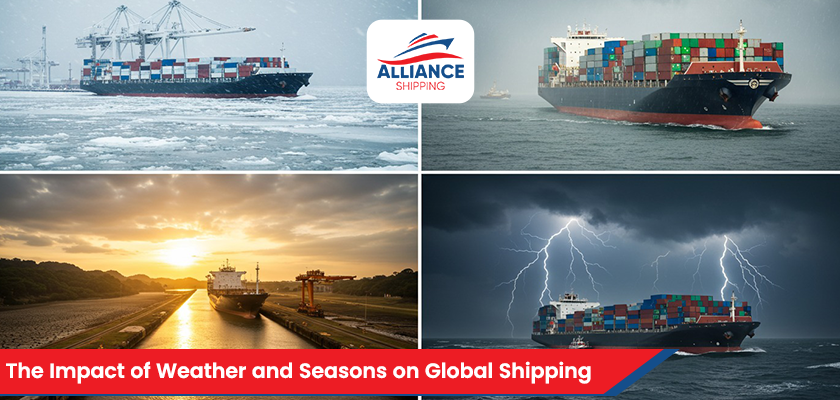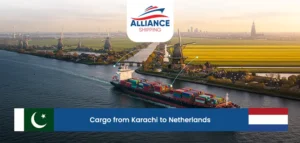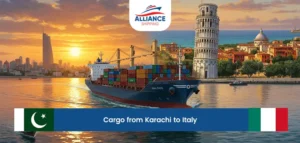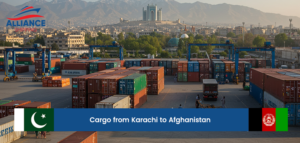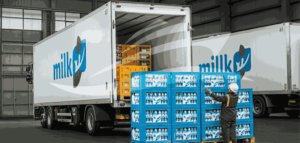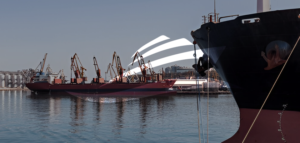World trade depends on global shipping. Approximately 90 percent of international products travel by sea and form a network of ships, ports, rail, air, and roads across continents. Many of the raw materials, such as oil and metals, as well as finished products that we use, like food, electronics, and clothes, have at one time crossed the ocean. Shipping allows making this world seem smaller, as it helps to connect producers and consumers in all areas of the Earth.
Nevertheless, despite all the improvements in technologies and logistics, there is one aspect, which cannot be controlled by people: the weather and seasons. They become the greatest cause of uncertainty in international shipping. A storm in the Pacific, a hurricane in the Atlantic, or ice in northern waters can disrupt schedules, cause ships to reroute, and delay cargo reaching its destination. Such disruptions may not be visible to businesses and customers at first, but they usually result in emptying the shelves, price increases, or delayed shipments.
That is why companies need to have strategies that incorporate weather and seasonal changes. It is not the case of tracking forecasts, but about building flexibility into the supply chain. Firms that deal in goods transported worldwide must do so with an eye towards the future because it is preferable to select safer routes, allocate more time as a buffer, and work with suppliers that are capable of rapid adaptation. At Alliance Shipping, we have witnessed how proactive measures can help to minimize the risk and ensure the continuity of trade during times when nature has thrown a curveball in our way.
In the end, global shipping shows us how connected we are and how much the rhythm of trade still depends on the rhythm of nature.
Key Weather Events That Disrupt Shipping
Like highways on the land, shipping routes are exposed to the full nature, minus the vehicle they carry. Weather events may come unexpectedly and their effects are normally broad-reaching. Whether it is storms or heatwaves, weather patterns pose a variety of risks to ships, ports and cargo they transport. Some of the major weather patterns that interrupt international shipping will be discussed.
Storms & Hurricanes
Storms and hurricanes can be considered among the riskiest weather conditions in shipping. These storms can shut down a shipping lane in the Atlantic, Pacific and South China Sea. Guaranteeing the security of workers and equipment, ports are often closed in advance. Vessels at sea will have to re-route, thereby increasing the days of the journey. In extreme incidences, intense waves and strong winds contribute to the loss of containers, where the cargo is washed overboard. Besides safety issues, such disturbances rebound on supply chains, making them more costly and time consuming.
Snow & Ice
The cold regions have their problems too In parts of North America, Baltic Sea, and Russia, the winter brings snow and ice can freeze ports and waterways. Ships may require icebreakers in order to transit and this slows down the operations. On land, moving goods after getting to the port is hampered by snowstorms which may block rail lines and roads. These requirements induce bottlenecks particularly to the flow of energy such as oil and coal that may be highly transported during the winter.
Heatwaves & Droughts
The result of rising global temperatures is another problem-low water levels. In Panama Canal and the Rhine River in Europe, droughts shallower the length of the streams. Ships must make lighter loads, and this reduces efficiency and increases costs. In case of major trade route, a minor diminution in the capacity of vessels is tremendously costly.
Fog, Wind, & Monsoons
Other factors, such as bad weather like fog and excess wind, and seasons of monsoons, also interfere with shipment. Fog causes delays in flights and the movement of vessels. Large winds pose hazards to berthing in ports. In Asia, the floods which are caused by the monsoons are slowing the operations of the ports and destroying infrastructure. In combination, these factors make weather one of the most imposing variables in international trade.
Seasonal Impacts by Region
Global shipping is not a worldwide process that is done at the same pace every time. Ships as well as ports are like seasonal activities and need to change/adapt with the change of seasons. Each season brings unique challenges—from frozen seas to hurricane winds—that affect how goods move across continents. Knowing these seasonal effects is very crucial to businesses that take advantage of the supply chain.
Winter (Europe, North America, Asia)
Winter means some of the most difficult shipping conditions. In Northern Europe, North America, and Asia, low temperatures result in the freezing of the ports and waterways. In rivers and northern waters break-through of ice is frequently necessary before vessels can move, slackening the flow of traffic. Running on land, snowstorms may lock the means of transport by road or rail, and it is hard to ensure that goods receive their final destination even when they are shipped. Such slowdowns are particularly a setback to industries that rely on constant deliveries during winter like fuel and heating.
Spring
With the coming of spring, river systems that have their source in the mountains may flood due to melting of the snow thereby interrupting land transport by waterways and rail system. Meanwhile, weather becomes unpredictable and there are storms that affect sea routes. Ports will be forced to stay on top of slip-ups as spring flooding and storms cause temporary havoc. To the business sphere, this translates to prepping up schedules and expect shaky times as commuting duration may be a wild card during this period of transition.
Summer
During summer, the prime hazards become hurricanes in the Americas and typhoons in Asia. These strong storms cause ports to close and vessels to divert and in many cases create backups when ports reopen. Heatwaves are also known to slow the port labor comprising loading and unloading. Summer is among the busiest period in the global trade, and even the slightest delay can spread far and wide in terms of knock-on effects.
Autumn
Autumn is also a transitional period, which however brings with it its own dangers. Early snows in northern climes have the effect of interrupting road and rail transport, and late season snowstorms still jeopardize shipping routes. Autumn is a time of preparation as companies get ready both to keep summer storm patterns in mind and the inevitability of winter slowdowns.
Real-World Case Studies
Panama Canal Drought (2023)
In 2023, El Ni o caused a strong drought that compelled the Panama Canal Authority to drastically decrease daily transits – down to only 1822 ships per day at the end of the year 2023 and into 2024. This resulted into long queues at the vessels, delays and reduced reliability in one of the major routes in the world. The drought halted the transport of goods and created a chain reaction of damaging supply chains, a problem that clearly proves the susceptibility of global shipping network to the effects of water scarcity.
Ever Given Suez Canal Blockage (2021)
In March 2021, the Ever Given container ship, a key cause of the week-long blockage of the Suez Canal, lost steering after a reported sandstorm made steering difficult in high winds. The ship traffic was also in a standstill and this resulted in major losses to the global trade. The event exposed the vulnerabilities of how the world logistics could be disrupted in a short-term by even weather events.
Maersk Essen Container Loss in Pacific Storm (2021)
On January 16, 2021, the Maersk Essen, a 13,100-TEU containership, ran into difficult weather in North Pacific and lost approximately 750 containers. The company subsequently declared that the crew was safe and it was conducting intensive cargo investigation. This occurrence accentuated the practical dangers of rough seas and storms that challenge the integrity of cargo and with heavy repercussions to business and supply chains.
Business Impacts of Weather on Shipping
Rough seas are not the only disruption caused by weather, as these go beyond businesses, customers and worker. When there is slow shipping, it becomes costly, delivery gets delayed, and there is a risk of danger to people and cargo. So what are the primary business implications?
Costs
A heavy weather may require ships to change the course, which may be hundreds of miles. The greater the number of miles the greater the fuel consumption, the increased operating expenditures and sometimes the more it costs to insure the commercial vehicle due to it being high risk. There are also the demurrage premiums that occur when the containers stay longer than usual at the ports as a result of delays. To businesses, these incremental costs have the potential to consummate profit margins.
- Extra fuel from rerouting
- Higher insurance during storm seasons
- Demurrage and storage fees when ports close
Delays
When ships can’t move on schedule, entire supply chains feel the ripple. Shelves stay empty, factories wait for raw materials, and customers grow frustrated. One storm in the Pacific can delay goods across multiple continents, showing how interconnected modern trade has become. Businesses must often hold extra inventory or find backup suppliers to cope with this uncertainty.
Cargo Risks
Not all cargo handles delays the same way. Perishable goods like fruit and seafood spoil quickly. Electronics may be damaged by moisture if containers are exposed too long at port. Even hazardous goods pose safety risks if stuck in unsuitable conditions. Weather makes these risks harder to control, which adds to insurance claims and financial loss.
Safety Risks
At the heart of shipping are people. Seafarers face storms at sea, truck drivers handle icy roads, and dockworkers operate in extreme heat or heavy rain. Weather events put pressure on safety, and accidents can happen if conditions worsen. Protecting workers while keeping trade moving is one of the hardest balances in global shipping.
How Businesses Can Prepare & Mitigate Risk
It is true that weather cannot be predicted but it does not mean that businesses cannot fight its negative impact on ships around the world. Working with smarter tools, improved planning, and more effective shipping partners, companies are able to limit risks and move goods during times when storms or delays occur. The key strategies in order to help secure supply chains, minimize expenses and cope with a shifting climate include forecasting, assuring contractual flexibility, and route flexibility.
Technology
Technology plays an important role in modern shipping. Automated forecasting, satellite tracking and live tracking offer companies a better idea of what is happening. Ships will be able to reroute quicker, ports will be able to make preparations earlier and logistics staff can update customers more precisely. The result of the above use of technology is that it eliminates the element of doubt and replaces it with an informed decision and it saves businesses a number of hours, money and diminishes the element of surprise given to extreme weather.
Insurance & Contracts
The weather disruptions are not always avoidable and therefore a strong insurance and contract matters. Marine insurance and cargo cover help cover the financial costs of goods carried and weather clauses in contracts allocate the responsibility between the shipper and the client. This will ensure that in cases where delays arise the business is not left footing the full bill. Being insured gives relief and good finances in case of permitable weather conditions.
Operational Planning
Smart operational planning assists the companies to align. Instead of avoiding risks and shutting down the production process, companies can overcome unforeseen delays by routing shipping demands in various directions, developing flexible shipping schedules and maintaining trouble-causing inventory reserves. The resilience is particularly critical to industries processing perishable goods or those with just-in-time supply-chains. Organizations that anticipate are usually the ones that will get back on their feet quicker and consistently satisfy their clients even during the period of disruption.
Sustainability
Businesses should think long term. Due to climate change, an increase in extreme weather is becoming more common, thus green investments such as energy-saving ships, use of new routes, including the Arctic, and the minimization of emissions become not only a sustainable move towards a clean environment but also a good business as well. It gives companies an edge in the future as companies with sustainable practices are prepared to change with the environment in shipping.
Looking Ahead: Climate Change & The Future of Global Shipping
The effect of climate change will dominate the future of global shipping. Weather is already the greatest source of uncertainty in trade, and increasing global temperatures are making that even more difficult. Researchers predict more frequent storms and increasingly uncertain seasons so shipping routes will be subject to greater risk of disruption. To companies and their consumers, it means increased stipends, time wastage and the constant necessity of better backup solutions
One of the biggest changes is occurring in the far north. Sea routes across the melting ice sheets of the arctic ocean are starting to open up, which could save days on the shipping time between Asia and Europe. Although this may seem an opportunity, there are also new risks associated with it such as the fact that ice can become unpredictable, there are delicate ecosystems and no rescue or repair infrastructure especially in such remote regions. Companies considering such passages have to calculate the advantage of the shorter routes and the need to exercise precautions and safety about the environment.
Simultaneously, there are increasing calls on the shipping industry to become green. Ships and lines are investing in fuel-efficient vessels, testing alternative fuels like LNG, biofuels and even hydrogen, and redesigning how freight moves regionally. This is not only to reduce emissions but rather to have strong logistics networks that can react when weather or climate events occur.
Going forward, it is evident that shipping will continue to be the engine that drives international trade, but it must be able to adapt with the changing climate, be sustainable and show a profound understanding of the movements in the climate.
Frequently Asked Questions
Businesses can reduce risks by:
- Using real-time weather tracking to adjust routes.
- Including weather clauses in contracts for shared responsibility.
- Maintaining buffer inventory to absorb delays.
- Choosing reliable partners with flexible logistics solutions.


